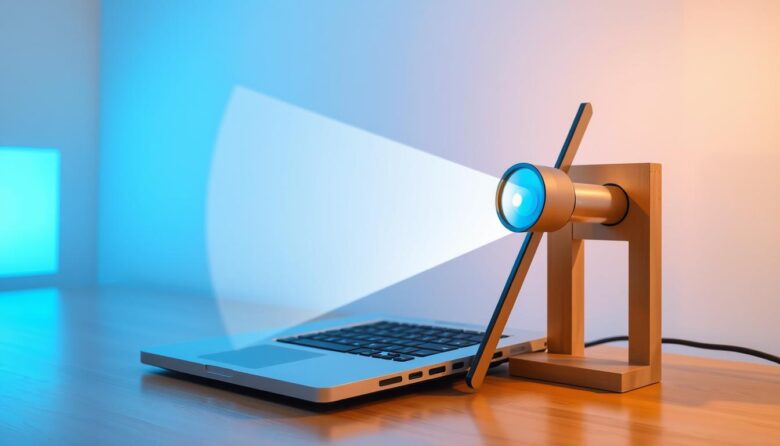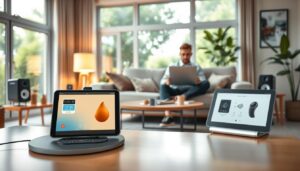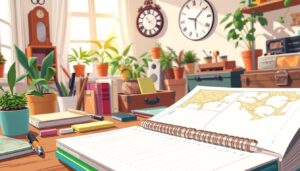Creating a personalized viewing experience doesn’t require expensive equipment. This step-by-step guide reveals how everyday items can become tools for crafting a functional entertainment device. You’ll learn core principles of light physics while repurposing materials you already own.
Many enthusiasts enjoy this activity for its blend of education and practicality. By understanding how light bends and focuses, you gain insights applicable to photography, engineering, and even astronomy. The process also promotes sustainability by giving old items new life.
Designed for beginners, our tutorial requires no technical background. Clear instructions walk through each stage, from gathering supplies to adjusting image clarity. Common challenges like blurry visuals or dim lighting receive special attention to ensure success.
Beyond movie nights, this creative solution works for classroom presentations or displaying digital art. It’s an ideal weekend activity for families or students exploring STEM concepts. You’ll finish with a working device and skills to tackle more complex builds.
Setting the Stage for Your DIY Projector
Mastering projection starts with grasping how light transforms digital content into large-scale visuals. Commercial systems like LCD and DLP models use advanced methods, but their core principles mirror what you’ll achieve with basic materials.
Understanding the Basics of Projection
Professional devices split light through prisms or microscopic mirrors to create images. LCD units separate colors through glass panels, while DLP systems rely on rapid mirror movements. Your homemade version simplifies this by directing a concentrated beam through a lens to magnify content.
Distance between the light source and lens determines image size. Closer spacing creates smaller visuals, while greater gaps enlarge them. Sharpness depends on precise alignment – a principle that applies whether building with cardboard or engineering commercial projectors.
The Importance of Light and Image Dynamics
Brightness directly impacts visibility. Stronger illumination cuts through ambient light, making projections clearer. This explains why commercial models use high-lumen bulbs, while your setup maximizes device brightness.
Lens quality affects focus and color accuracy. Imperfections cause blurring or chromatic distortion. By positioning reflective surfaces strategically, you counteract common issues like flipped images – a challenge both premium and DIY systems solve through geometric adjustments.
Contrast ratios determine how well objects stand out against backgrounds. Minimizing light leaks in your build preserves these relationships, just as sealed housings maintain integrity in professional gear. Every design choice supports the goal: crisp, vibrant reproductions.
Materials and Tools You’ll Need
Quality components transform basic items into projection powerhouses. Selecting the right elements ensures crisp visuals and stable operation. Focus on durability and precision to maximize your build’s performance.
Essential Materials: Cardboard, Lens, and More
A shoebox provides the ideal housing due to its compact shape and light-blocking walls. Opt for thicker cardboard variants to maintain structural integrity. The magnifying glass acts as your optical engine – choose one with smooth curvature and minimal surface flaws.
Foam board creates adjustable mounting platforms inside the box. Black duct tape seals gaps around the lens opening and edges. For light-sensitive interiors, line surfaces with matte paper to absorb reflections.
Recommended Tools for Cutting and Assembly
Precision tools like X-ACTO knives ensure clean cuts through cardboard walls. Use a hacksaw for enlarging the lens hole if needed. A hot glue gun secures components faster than standard adhesives while allowing repositioning during setup.
Measure twice with a metal ruler before making permanent modifications. This prevents misaligned parts that distort images. Keep multiple glue sticks handy – rapid bonding minimizes shifts during assembly.
Understanding the Science Behind Projectors
The mechanics behind projecting visuals involve precise manipulation of light and optics. Professional systems employ advanced methods that mirror principles applicable to homemade designs. Let’s explore how commercial technologies function and why these concepts matter for your build.
LCD vs. DLP: How Different Technologies Work
LCD projectors channel intense illumination through a prism, splitting it into red, green, and blue components. These colors pass through liquid crystal panels that regulate individual pixel brightness. Combined light beams then travel through a lens to form the final picture.
DLP systems use microscopic mirrors on a digital chip to reflect light from a spinning color wheel. Each mirror represents a pixel, tilting thousands of times per second to create shades and hues. This method excels with dynamic video content due to rapid response times.
Optics, Focus, and the Role of the Lens
Focal length dictates how light converges from the source to the viewing surface. A high-quality glass lens minimizes distortion while maximizing brightness retention. Positioning adjustments compensate for inverted visuals – a challenge solved in commercial units through mirror arrays.
Ambient illumination competes with projected images, reducing clarity. Dark environments enhance contrast by eliminating this interference. Whether using premium components or DIY tools, these optical rules govern every successful projection.
Step-by-Step Phone Screen Projector Hack
Transforming everyday materials into a functional display system combines practical skills with optical science. This process rewards attention to detail while teaching fundamental principles of light manipulation. Follow these steps to convert basic supplies into a temporary entertainment or presentation tool.
Preparing Your Box and Lens Placement
Start by modifying your magnifying glass. Remove its handle using steady hacksaw strokes, creating smooth edges for secure mounting. Strengthen the cardboard structure by applying adhesive to interior joints – this prevents shifting during use.
Mark the lens position by centering it on the box’s largest surface. Trace a precise circle slightly smaller than the glass diameter. Cut carefully with a utility knife, preserving the opening’s shape for tight lens seating.
Calibrating Your Smartphone for Optimal Projection
Construct a vertical foam platform inside the container. This stand must align perfectly with the lens axis to prevent warped visuals. Secure your device using removable adhesive strips for easy adjustments.
Activate maximum brightness settings and disable auto-rotate features. Position the smartphone upside-down – light inversion through the lens corrects the orientation during projection. Test different distances from the glass to achieve sharp focus.
Creative Adjustments for Enhanced Projection
Perfecting your homemade display involves precise adjustments to maximize visual quality. These refinements transform basic functionality into theater-level performance using simple modifications. Let’s explore techniques to elevate clarity and adapt to different viewing environments.
Fine-Tuning Focus and Brightness Settings
Focus adjustment begins with incremental device movement relative to the lens. Shift the light source forward or backward in half-inch increments while observing projected sharpness. This method identifies the “sweet spot” where edges appear crisp and text becomes legible.
Balancing brightness requires managing two factors: source intensity and ambient light. Maximize your device’s output while darkening the room for optimal contrast. For daytime use, position the setup closer to the viewing surface to concentrate illumination.
Create a paper aperture shroud to enhance edge definition. Cut a credit card-sized rectangle in thick cardboard, then mount it before the lens. This modification sharpens images by reducing scattered light, though it slightly dims output. Test different opening sizes to match your content needs.
Distance directly impacts both size and clarity. Closer positioning produces smaller but intensely vivid images, ideal for detailed graphics. Further placement enlarges visuals while requiring stricter light control. Adjust these variables based on whether you’re showcasing art or streaming video.
Troubleshooting Common DIY Projector Challenges
Even well-planned builds can encounter unexpected issues. Understanding common challenges helps transform minor setbacks into learning opportunities. This section addresses frequent concerns and provides practical solutions to enhance your viewing experience.
Addressing Image Flipping and Inversion Issues
Inverted visuals occur because light bends through curved surfaces. Flip your device upside-down before securing it in the box to counteract vertical reversal. For horizontal correction, position a mirror at 45 degrees between the lens and viewing surface.
Make sure to activate rotation lock settings on your source. This prevents automatic adjustments that could undo your fixes. Test alignment by projecting simple shapes before moving to complex content.
Ensuring Stability and Avoiding Light Leakage
Seal all seams with opaque tape to block stray illumination. Pay special attention to the lens mount area, where gaps often form. Line interior walls with dark fabric to absorb residual light bouncing inside the chamber.
Also use weighted objects to anchor your setup during use. This prevents accidental shifts that blur the image. For maximum clarity, work in darkened spaces – covered windows eliminate competing ambient brightness.



